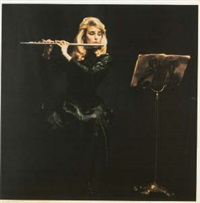My final exhibition will focus on the works of Chen Yifei during Mao’s reign as well as after Mao’s death in 1976. Chen was a well respected artist in the eyes of the Communist party leaders for his artwork portraying the devotion of communist soldiers as well as their battles against the Nationalist and Japanese forces.
Chen caught the eye of the officials in the Communist party for his adoption of the Socialist Realism style early on in his career. The socialist realist art style reflected the socialists in a positive, strong, and inspiring light in order to create support for the party. Red Flag I (1971-72) was such a painting which drew support for the communist party from the viewer. This painting was a large portrayal of several communist soldiers who are ready to charge into battle. They all display the red star symbolizing the communist party on their hats and the soldier closest to the viewer — and as such is closest to the danger of the coming battle– is proudly holding the red flag. The soldiers show no fear in their faces, rather they show pride and confidence in the face of death. These details combined with the vast size of the painting displays a sense of pride in the viewer and evokes a feeling of being protected by the communist party.
After the death of Mao, Chen’s works change drastically to focus on individual portraits. One such portrait titled, The Flutist (1987), portrays a woman playing the flute while in an elegant black dress. This is a drastic change from Chen’s previous works as it portrays the subjects individual wealth and talent which contrasts the communist ideals of equality for everyone. This change was inspired by Chen’s move to New York in 1980 where he studied western art.
This change displays how restrictions on art were loosened after Mao’s death and artists were able to created what they were passionate about. The emphasis on portraying the communist party was diminished and as such artists from across China began to express themselves through styles other than Socialist realism.

Chen Yifei, Red Flag I, Oil on Canvas, Dimensions: 300 x 159 cm (118.1 x 62.6 in.), 1971-1972. Source: http://www.artnet.com/artists/chen-yifei/red-flag-1-tBXyFFUh-0HVcgGfbG-bXA2

Chen Yifei, The Flutist, Offset Lithograph, Dimensions: 69.5 x 69.5 cm. (27.4 x 27.4 in.), 1987. Source: http://www.artnet.com/artists/chen-yifei/the-flutistthe-flutist-Gg00GSjS9MnWCl48qZ9ChQ2
Works cited:
“Chen Yifei.” Chen Yifei Biography – Chen Yifei on artnet. Accessed May 8, 2020. http://www.artnet.com/artists/chen-yifei/biography.
“The Flutist – Chen Yifei – Google Arts & Culture.” Google. Google. Accessed May 15, 2020. https://artsandculture.google.com/asset/the-flutist-chen-yifei/JgHtUATxu6SBqg.


I found this post interesting because it is comparing Chen Yifei and his works during Mao Zedong’s reign and also after his death. Similarly, I am comparing the historical significance of how the reign of the Communist Party affected my artist, Li Keran, as well in my exhibition. Li Keran was imprisoned for expressing himself through his works of art and had to evolve his form to conform to the views of the Communist government. I found it interesting how the artists’ works contrast in meaning due to the role of the Communist Party (one made works supporting the Communist Party while thee other did not), but after the death of Mao, the artists were drastically changed their form and were able to express themselves differently.